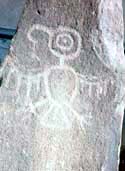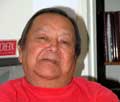Listen as Marcie Macy reflects on the coming of Lewis and Clark among the Wasco and Warm Sprigs people and what could have happened. (Interviewed by F. Duran Bobb. January 2003.)
Marcie Macy reflects on the role of Sacagawea while among the Wasco and Warm Springs people. (Interviewed by F. Duran Bobb. January 2003.)
 | | Thunderbird Petroglyph. |
On October 28, Lewis and Clark first saw the majestic condors, referred to as “beautiful buzzards,” soaring high along the Columbia River. Archaeologists have subsequently unearthed the bones of this giant bird dating back over 9,000 years. With its natural habitat disrupted, the last condor was seen in Oregon in 1904. Today as part of the California Condor Recovery Program, the birds are being re-introduced to the land and people who have since time immemorial honored them. Often called by the Wasco as the “Thunderbird,” it an important being in the oral traditions and was understood as a helper of the human peoples, protecting them from natural disasters. The image of the Thunderbird has been an integral design motif on basketry and on the rock art of the area. The feathers of the condor were an important ritual item in ceremonies.
Important to the legacy of the land and the Indian people is the restoration of the condor, as well as the safeguarding of its associated petroglyph art, along with all petroglyph art along the Columbia. It is for this reason that we are reluctant to identify the locations of rock art, for fear of vandalism to and thieft of these cultural treasures. In the instance of the image above, it along with over forty other petroglyphs that would have been destroyed by building of The Dalles Dam, are now relocated for safe keeping and public display at Horsethief Lake State Park, Washington. Our shared cultural heritage is to be honored and preserved for the future generations, so all can continue to learn and appreciate the rich heritage of this land and its peoples.
Information courtesy Olivia Wallulatum and the Governmental Affairs Office of the Confederated Tribes of Warm Springs.
|
|
| The arrival of Meriwether Lewis and William Clark was indeed a defining moment in the tribal histories of the Wasco and Warm Springs people. However, at the time, our ancestors likely saw the Corps of Discovery’s journey as simply another small group of traders making their way through our lands. They did not stay long amongst us, did not have trade items new to us, and were not particularly friendly. As a matter of fact, they were rather hostile when they were leaving our lands. As the most important trading center in all the Northwest since time immemorial, Celilo Falls and The Dalles area in 1805 had already witnessed many other visitors and trading parties from exotic and distant lands. Russian, Spanish and English, as well as Chinese and Japanese merchants had long been interacting and trading with the area tribes. And white-skinned peoples were not a new phenomena to us, as some had already married into families down river and, as Lewis and Clark even observed, raised their children among us.
|
|
Brenda Scott, of Wasco and Paiute heritage, talks about the loss that came as a result of the coming of Lewis and Clark, and the eventual move of the people to what would later be called "Warm Springs." Warm Springs is a place the people "love." If the people had stayed along the river, they would have likely perished. (Interviewed by Brigette Whipple and F. Duran Bobb, October 18, 2002) |
While it is true that the Corps of Discovery witnessed considerable activity along the Columbia River at the time of encounter (arriving October 21 to 29, 1805 and returning April 13 to 23, 1806), Lewis and Clark did not come close to grasping how essential Celilo Falls was to the economy and social life of the region. They had missed some of the peak fishing and trading activities of the yearly seasonal round. As an advanced guide of an "expanding empire," Lewis and Clark could have better appreciated how control of this key commercial center would be advantagous. This was an appreciation the United States military did not overlook when they established Fort Dalles in 1850.
|
|
Jacob Frank, a Warm Springs elder, reflects on the over-all significance and legacy of Lewis and Clark. (Interviewed by F. Duran Bobb and Tim Finch, December 2002) |
 | | the Dalles Dam with Mt. Hood in the background, ca. 1981. |
While our ancestors of 1805 had no way of comprehending the inevitable consequences of the arrival of Lewis and Clark, contact with these odd smelling and disrespectful men marked the point in time that indeed began a rapid change and seemingly overwhelming challenge to our very way of life. With the expansion of the American frontier to include our sovereign lands, our ancestors saw incurable diseases spread like the wind over the lands, killing especially the young, our future generations, and the old, the caretakers of our wisdom. Missionaries soon arrived to ridicule our most cherished beliefs and forbid the practice of our life-renewing ceremonies. In the wake of the diseases, a flood of homesteaders brought demands for our lands, and wars and defeats soon followed. The military generals were replaced by treaty commissioners, and a “reservation” was established for us in 1855. We were removed from the heart of the places the Creator had reserved for us since time immemorial. And still another flood was experienced in March of 1957, as the waters rose behind concrete dams and inundated our traditional fishing areas, the very existence of the salmon would be threatened. While many may celebrate the journey of Lewis and Clark, as it represents for them the growth of their sovereign state, that same journey marks the beginning of the greatest challenge to our sovereignty and our ways of life.
|
|
Employed by the Tribe since 1952 and currently the Director of Tribal and Public Relations, Rudy Clements, of Wasco and Warm Springs heritage, reflects on the significance of Lewis and Clark and refers to them representing "an invasion on our tribal spirituality and sovereignty." "It is anything but a celebration." (Interviewed by Rodney Frey and Larry Macy, July 2003) |
While the encounter with Lewis and Clark was among the greatest challenges we and our ancestors have ever confronted, it also symbolizes a challenge we have faced and have successfully met. As you will hear and see in the pages of this module, the ways of life of the Warm Springs, Wasco and Paiute peoples remain vital and dynamic. Our traditions are still practiced. Our economy has adopted to global markets. Our sovereignty is being reasserted. And the grandparents and grandchildren share in their love and care of our homelands.
|
|
Maxine Switzler talks about the "good" and "talented people here," and dispells one of the lingering stereotypes often associated with Indians. (Interviewed by Brigette Whipple and F. Duran Bobb, October 2002) |
To continue listening to the interviews of our elders, go to Lewis and Clark Supplement.
© Confederated Tribes of Warm Springs 2003
< previous | next > |
|
|




 28K
28K 

 28K
28K 






